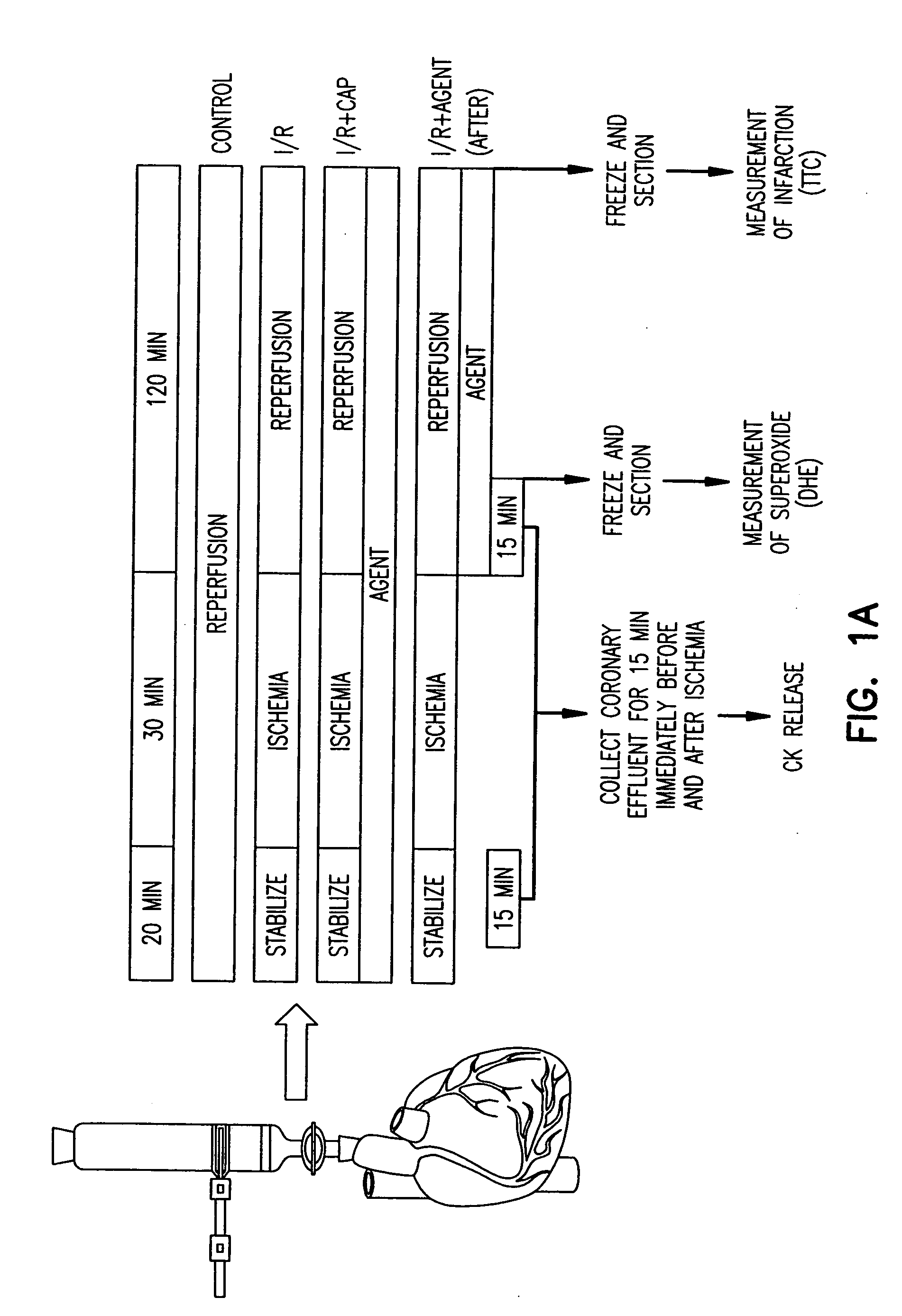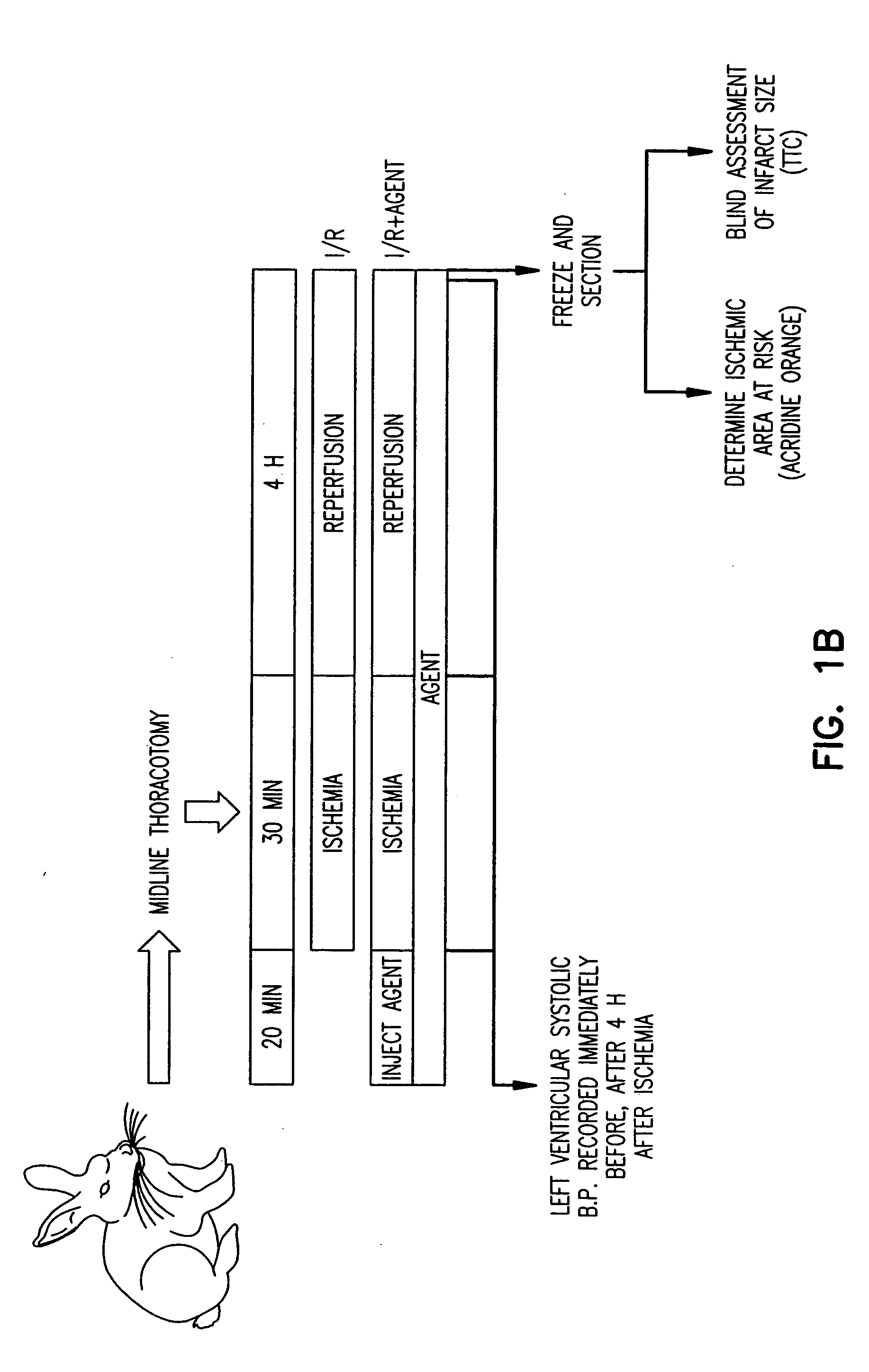Method to inhibit ischemia and reperfusion injury
a technology of ischemia and reperfusion injury, applied in the direction of biocide, antibacterial agents, drug compositions, etc., can solve the problems of lipid peroxidation and apoptosis, heart undergoes further damage, and the infarct size is reduced, so as to inhibit the cytochrome p450 enzyme, reduce the size of the infarct, and reduce the effect of infarct siz
- Summary
- Abstract
- Description
- Claims
- Application Information
AI Technical Summary
Benefits of technology
Problems solved by technology
Method used
Image
Examples
example i
Materials and Methods
Langendorff Perfusion and Global Ischemia / Reperfusion.
[0112] The global ischemia protocol was adapted from that of Tsuchida et al. (1994). All procedures were approved by the Animal Care and Use Committee at The Scripps Research Institute (TSRI). To obtain isolated hearts, hearts were excised from an anesthetized mammal such as a rabbit and quickly cannulated onto the Langendorff perfusion apparatus. The heart is perfused with Krebs-Ringer buffer for 15 minutes before ischemia / reperfusion episodes. No-flow ischemia is maintained for 30 minutes and reperfusion is accomplished by restoring flow for 15 minutes (unless otherwise indicated). Ischemic preconditioning can be induced by three 5 minute cycles of no-flow ischemia and reperfusion immediately preceding the regular ischemia and reperfusion.
[0113] In brief, the heart was excised from the anesthetized rabbit and quickly cannulated onto the Langendorff perfusion apparatus. The heart was perfused with Krebs-...
example ii
Methods
Langendorff Heart Perfusions.
[0147] All procedures were approved by the Animal Care and Use Committee at The Scripps Research Institute (TSRI). Rat hearts were perfused in Langendorff mode with Krebs-Ringer buffer as in Example I. CAP (300 μM) (Calbiochem, San Diego, Calif.), gentamicin sulfate (50 mg / ml) (Sigma, St. Louis, Mo.), ketoconazole (7.5 μM), sulfaphenazole (10 to 300 μm) (Sigma, St. Louis, Mo.) or cimetidine (200 to 600 μM) was added to the perfusion buffer 20 minutes before ischemia or upon reperfusion. No-flow ischemia was maintained for 30 minutes and reperfusion was accomplished by restoring flow for 15 minutes for creatine kinase (CK) release determination and dihydroethidium (DHE) staining, or 120 minutes for infarct size determination by triphenyl tetrazolium chloride (TTC) staining. Measurement of CK activity was performed using the CK EC 2.7.3.2 UV-Test kit (Sigma) as per the manufacturer's instructions. The measurement of infarct size after TTC stainin...
PUM
| Property | Measurement | Unit |
|---|---|---|
| thick | aaaaa | aaaaa |
| thickness | aaaaa | aaaaa |
| particle size | aaaaa | aaaaa |
Abstract
Description
Claims
Application Information
 Login to View More
Login to View More - R&D
- Intellectual Property
- Life Sciences
- Materials
- Tech Scout
- Unparalleled Data Quality
- Higher Quality Content
- 60% Fewer Hallucinations
Browse by: Latest US Patents, China's latest patents, Technical Efficacy Thesaurus, Application Domain, Technology Topic, Popular Technical Reports.
© 2025 PatSnap. All rights reserved.Legal|Privacy policy|Modern Slavery Act Transparency Statement|Sitemap|About US| Contact US: help@patsnap.com



